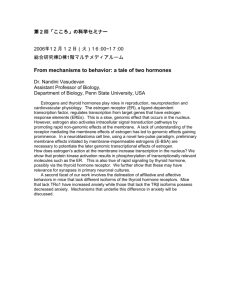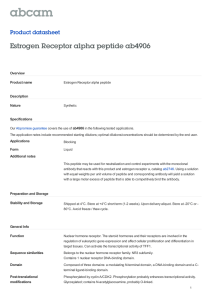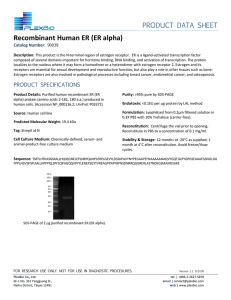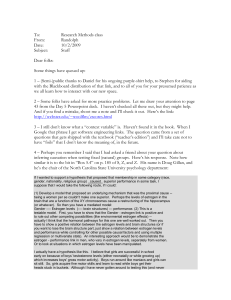Estrogen Receptor Transcriptional Activation (Human Cell Line
advertisement
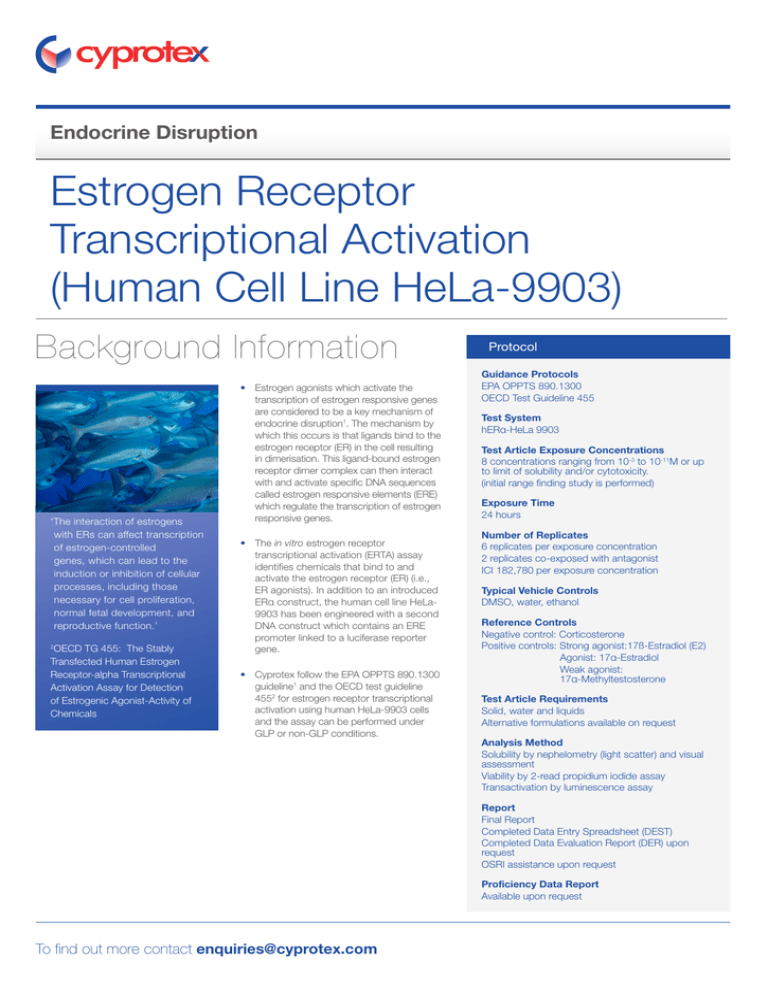
Endocrine Disruption Estrogen Receptor Transcriptional Activation (Human Cell Line HeLa-9903) Background Information ‘The interaction of estrogens with ERs can affect transcription of estrogen-controlled genes, which can lead to the induction or inhibition of cellular processes, including those necessary for cell proliferation, normal fetal development, and reproductive function.’ OECD TG 455: The Stably Transfected Human Estrogen Receptor-alpha Transcriptional Activation Assay for Detection of Estrogenic Agonist-Activity of Chemicals 2 • Estrogen agonists which activate the transcription of estrogen responsive genes are considered to be a key mechanism of endocrine disruption1. The mechanism by which this occurs is that ligands bind to the estrogen receptor (ER) in the cell resulting in dimerisation. This ligand-bound estrogen receptor dimer complex can then interact with and activate specific DNA sequences called estrogen responsive elements (ERE) which regulate the transcription of estrogen responsive genes. • The in vitro estrogen receptor transcriptional activation (ERTA) assay identifies chemicals that bind to and activate the estrogen receptor (ER) (i.e., ER agonists). In addition to an introduced ERα construct, the human cell line HeLa9903 has been engineered with a second DNA construct which contains an ERE promoter linked to a luciferase reporter gene. • Cyprotex follow the EPA OPPTS 890.1300 guideline1 and the OECD test guideline 4552 for estrogen receptor transcriptional activation using human HeLa-9903 cells and the assay can be performed under GLP or non-GLP conditions. Protocol Guidance Protocols EPA OPPTS 890.1300 OECD Test Guideline 455 Test System hERα-HeLa 9903 Test Article Exposure Concentrations 8 concentrations ranging from 10-3 to 10-11M or up to limit of solubility and/or cytotoxicity. (initial range finding study is performed) Exposure Time 24 hours Number of Replicates 6 replicates per exposure concentration 2 replicates co-exposed with antagonist ICI 182,780 per exposure concentration Typical Vehicle Controls DMSO, water, ethanol Reference Controls Negative control: Corticosterone Positive controls: Strong agonist:17ß-Estradiol (E2) Agonist: 17α-Estradiol Weak agonist: 17α-Methyltestosterone Test Article Requirements Solid, water and liquids Alternative formulations available on request Analysis Method Solubility by nephelometry (light scatter) and visual assessment Viability by 2-read propidium iodide assay Transactivation by luminescence assay Report Final Report Completed Data Entry Spreadsheet (DEST) Completed Data Evaluation Report (DER) upon request OSRI assistance upon request Proficiency Data Report Available upon request To find out more contact enquiries@cyprotex.com ‘Perturbation of normal estrogenic systems may have the potential to trigger adverse effects on normal development (ontogenesis), reproductive health and the integrity of the reproductive system.2’ Figure 1 Representative graphs showing data from the Estrogen Receptor Transcriptional Activation assay using hERα-HeLa 9903 cells. B. 160 17ß-estradiol 140 17ß-estradiol + ICI 182,780 120 % Maximal Induction Control % Maximal Induction Control A. 120 100 80 60 40 20 0 Text Article X Test Article X + ICI 182,780 100 80 60 40 20 0 -20 -15 -13 -11 -9 -11 -9 -7 Concentration (log M) Concentration (log M) The data in Figure 1A represent the potent positive reference control, 17β-estradiol (dark blue circles), and 17β-estradiol coexposed with the hERα-HeLa 9903 antagonist, ICI 182,780 (light blue circles). As expected, in the presence of ICI 182,780, inhibition of the hERα-HeLa 9903 mediated induction of the luciferase gene is observed confirming 17β-estradiol as a true hERα-HeLa 9903 agonist. The data in Figure 1B represent a false positive test article X (dark blue circles) where non-specific (i.e., non-hERα-HeLa 9903-mediated) induction of the luciferase gene is occurring which is not inhibited by the potent hERα-HeLa 9903 antagonist, ICI 182,780 (light blue circles). For this reason, co-exposure with ICI 182,780 is essential for confirming a true hERα-HeLa 9903 agonist. Cyprotex and its partners are able to offer the full range of EDSP series 890 protocols. A number of general endocrine disruption screening services are also available. Related Services EDSP Series 890 OPPTS 890.1150: Androgen receptor binding (rat prostate cytosol) OPPTS 890.1200: Aromatase (human recombinant) Screening Services Estrogen Receptor Transactivation (ER-TA) Androgen Receptor Transactivation (AR-TA) Androgen Receptor (AR) Modulation OPPTS 890.1250: Estrogen receptor binding assay using rat uterine cytosol Estrogen Receptor alpha (ER-α) binding *OPPTS 890.1550: Steroidogenesis using human cell line H295R Androgen Receptor (AR) Binding Estrogen Receptor beta (ER-β) binding Steroidogenesis *OECD guideline available on request References 1 2 -5 OPPTS 890.1300: Estrogen Receptor Transcriptional Activation (Human Cell Line (HeLa-9903)) OECD TG 455: The Stably Transfected Human Estrogen Receptor-alpha Transcriptional Activation Assay for Detection of Estrogenic Agonist-Activity of Chemicals
